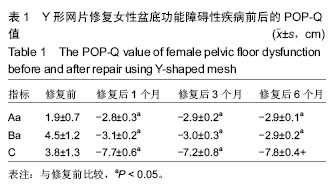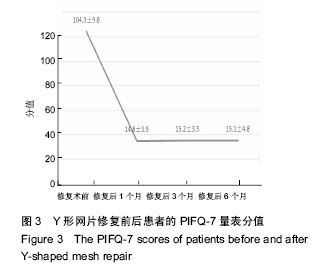| [1] Meldrum DR,Burnett AL,Dorey G,et al.Erectile hydraulics: maximizing inflow while minimizing outflow. J Sex Med. 2014;11(5):1208-1220.
[2] Yu SW,Rao SS.Anorectal physiology and pathophysiology in the elderly.Clin Geriatr Med. 2014; 30(1):95-106.
[3] Moldwin RM,Fariello JY.Myofascial trigger points of the pelvic floor: associations with urological pain syndromes and treatment strategies including injection therapy.Curr Urol Rep. 2013;14(5):409-417.
[4] Hong L,Li HF,Sun J,et al.Clinical observation of a modified surgical method: posterior vaginal mesh suspension of female rectocele with intractable constipation.J Minim Invasive Gynecol. 2012;19(6): 684-688.
[5] Mohammed N,Raschid Hoda M,Fornara P.Prolapse surgery in octogenarians: are we pushing the limits too far?World J Urol.2013;31(3):623-628.
[6] Dällenbach P.To mesh or not to mesh: a review of pelvic organ reconstructive surgery.Int J Womens Health.2015;7:331-343.
[7] Feldmann TF,Young MT,Pigazzi A.Incisional reinforcement in high-risk patients.Clin Colon Rectal Surg.2014;27(4):149-155.
[8] Wood LN, Anger JT.Urinary incontinence in women. BMJ. 2014;349:g4531.
[9] Musters GD,Buskens CJ,Bemelman WA,et al.Perineal wound healing after abdominoperineal resection for rectal cancer: a systematic review and meta-analysis. Dis Colon Rectum. 2014;57(9):1129-1139.
[10] Colaco M,Mettu J,Badlani G.The scientific basis for the use of biomaterials in stress urinary incontinence (SUI) and pelvic organ prolapse (POP).BJU Int. 2015;115(6): 859-866.
[11] Alvarez J,Cvach K,Dwyer P.Complications in pelvic floor surgery.Minerva Ginecol. 2013;65(1):53-67.
[12] Ahmad M,Sileri P,Franceschilli L,et al.The role of biologics in pelvic floor surgery.Colorectal Dis.2012;14 Suppl 3:19-23.
[13] Schey R,Cromwell J,Rao SS.Medical and surgical management of pelvic floor disorders affecting defecation. Am J Gastroenterol. 2012;107(11): 1624-1633.
[14] Abed H,Rahn DD,Lowenstein L,et al.Incidence and management of graft erosion, wound granulation, and dyspareunia following vaginal prolapse repair with graft materials: a systematic review.Int Urogynecol J.2011; 22(7):789-798.
[15] Haylen BT,Freeman RM,Swift SE,et al.An International Urogynecological Association (IUGA)/International Continence Society (ICS) joint terminology and classification of the complications related directly to the insertion of prostheses (meshes, implants, tapes) and grafts in female pelvic floor surgery.Neurourol Urodyn. 2011;30(1):2-12.
[16] Wagenlehner FM,Gunnemann A,Liedl B,et al. Functional aspects of pelvic floor surgery.Aktuelle Urol.2009;40(6):345-50.
[17] Baessler K.Do we need meshes in pelvic floor reconstruction?World J Urol. 2012;30(4):479-486.
[18] Toh VV,Bogne V,Bako A.Management of recurrent vault prolapse.Int Urogynecol J.2012;23(1):29-34.
[19] de Tayrac R,Letouzey V.Basic science and clinical aspects of mesh infection in pelvic floor reconstructive surgery.Int Urogynecol J.2011;22(7):775-780.
[20] Ashok K, Petri E.Failures and complications in pelvic floor surgery.World J Urol. 2012;30(4):487-794.
[21] Umoh UE,Arya LA.Surgery in urogynecology.Minerva Med.2012;103(1):23-36.
[22] Fleischer AC,Harvey SM,Kurita SC,et al.Two-/three- dimensional transperineal sonography of complicated tape and mesh implants.Ultrasound Q. 2012;28(4): 243-249.
[23] van Geelen JM,Dwyer PL.Where to for pelvic organ prolapse treatment after the FDA pronouncements? A systematic review of the recent literature.Int Urogynecol J.2013;24(5):707-718.
[24] Ga?czyński K,Futyma K,Bar K,et al.Bladder injury during sling operation in the treatment of SUI--review of literature and case report.Ginekol Pol.2012; 83(10): 784-788.
[25] Nosti PA,Iglesia CB.Medicolegal issues surrounding devices and mesh for surgical treatment of prolapse and incontinence.Clin Obstet Gynecol. 2013;56(2): 221-228.
[26] Park JH,Velu LK,Dayal SP,et al.Sacral osteomyelitis following restorative rectal cancer resection: a delayed presentation of dormant pelvic sepsis.Scott Med J. 2013;58(1):e20-23.
[27] Kow N,Goldman HB,Ridgeway B.Management options for women with uterine prolapse interested in uterine preservation.Curr Urol Rep. 013;14(5):395-402.
[28] Naumann G,Kölbl H.Current developments and perspectives on the diagnosis and treatment of urinary incontinence and genital prolapse in women.Aktuelle Urol. 2013;44(3):201-206.
[29] Chen B,Dave B.Challenges and future prospects for tissue engineering in female pelvic medicine and reconstructive surgery.Curr Urol Rep.2014;15(8):425.
[30] Dällenbach P.To mesh or not to mesh: a review of pelvic organ reconstructive surgery.Int J Womens Health.2015;7:331-343.
[31] Alas AN,Anger JT.Management of apical pelvic organ prolapse.Curr Urol Rep. 2015;16(5):33.
[32] Rickert A,Kienle P.Laparoscopic surgery for rectal prolapse and pelvic floor disorders.World J Gastrointest Endosc.2015;7(12):1045-1054.
[33] Halwani Y,Nicolau-Toulouse V,Oakes J,et al. Transvaginal strangulated small intestinal hernia after abdominal sacrocolpopexy: case report and literature review.Hernia.2013;17(2):279-283.
[34] Santen RJ.Vaginal administration of estradiol: effects of dose, preparation and timing on plasma estradiol levels.Climacteric.2015;18(2):121-134.
[35] Given FT Jr,Muhlendorf IK,Browning GM.Vaginal length and sexual function after colpopexy for complete uterovaginal eversion.Am J Obstet Gynecol. 1993;169(2 Pt 1):284-287.
[36] Scarpero HM,Cespedes RD,Winters JC. Transabdominal approach to repair of vaginal vault prolapse.Tech Urol.2001;7(2):139-145.
[37] Mendivil AA,Rettenmaier MA,Abaid LN,et al.Survival rate comparisons amongst cervical cancer patients treated with an open, robotic-assisted or laparoscopic radical hysterectomy: A five year experience.Surg Oncol.2015.pii: S0960-7404(15)30026-8.
[38] Llarena NC,Shah AB,Milad MP.Bowel injury in gynecologic laparoscopy: a systematic review.Obstet Gynecol.2015;125(6):1407-1417.
[39] Graziano A,Lo Monte G,Piva I,et al.Diagnostic findings in adenomyosis: a pictorial review on the major concerns.Eur Rev Med Pharmacol Sci. 2015;19(7): 1146-1154.
[40] Roach MK,Thomassee MS.Acquired Uterine Arteriovenous Malformation and Retained Placenta Increta.Obstet Gynecol.2015;126(3):642-644. |
.jpg)


.jpg)
.jpg)
.jpg)